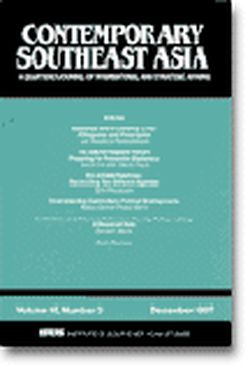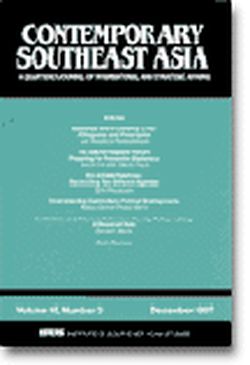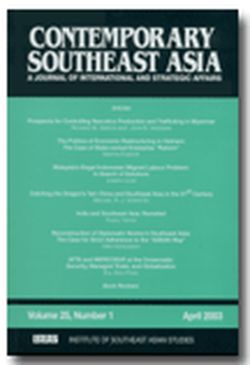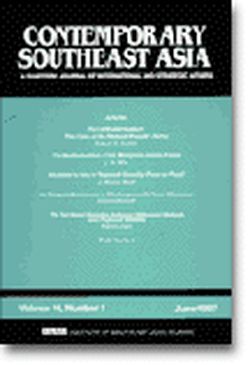Contemporary Southeast Asia: A Journal of International and Strategic Affairs Vol. 13/1(June 1991)

Date of publication:
June 1991
Number of pages:
117
Code:
CS13/1
Contents
-
Preliminary pages
- ARTICLES
-
Changing Global Trends and Their Effects on the Asia-Pacific, by Chin Kin Wah, author see abstractThis article broadly surveys the thawing of the various Cold War relationships since 1989 and seeks to account for the trends underlining these international changes. The effects of various developments, such as the change in superpower relations and the emergence of multipolarity, the shifts from geopolitics to geoeconomics, the decline of ideological affiliations, the democratization tendencies, and the persistence of regional disorder are discussed in turn. The impact and implications of such international changes upon the security environment of the Asia-Pacific, including ASEAN, are finally highlighted.
-
Domestic Changes in China Since the 4 June Incident and their Implications for Southeast Asia, by Lee Lai To, author see abstractFor the states of Southeast Asia, change in an important extra-regional power such as China, of whatever form and magnitude, cannot pass unnoticed. This is especially true of the developments arising from the Tiananmen incident in 1989. This article revolves around an analysis of the ramifications of the incident for the leadership contest and the direction of economic and political reform in China. It reaches the conclusion that the focus of China's domestic and foreign policies will be on achieving economic development. For this to occur, China will seek to maintain good relations with the ASEAN member states in order to recover support within the international community as a whole, and thus continued economic assistance. China, therefore, is likely to try to downplay any regional disputes and establish its place in the post-cold war world through economic performance.
-
Malaysian Defence Policy: Strategy versus Structure, by Richard Stubbs, author see abstractMalaysia is facing a changing security environment. The traditional insurgency and external land-bused threats have given way, in the lost few years, to predominantly maritime-based threats to the country's security. This change in the source of the dangers that the Malaysian Armed Forces must confront clearly necessitates a change in strategy. However, both economic and institutional constraints will make it more difficult than some analysts have anticipated to make the changes in Malaysias force structure that are required for a shift in strategy.
-
Major Asian Powers and the Development of the Singaporean and Malaysian Armed Forces, by Derek da Cunha, author see abstractThis article examines the extent to which the strategically influential role of the major Asian powers - China, Japan and India has been a factor in the development of the Singaporean and Malaysian armed forces in recent years. It looks at the subject from a historical perspective, that is, in the context of a policy continuum, and, inter alia, relies on policy statements, force structure development, and the revitalization of defence pacts to support its contention that concern about the intentions of the Chinese, Japanese and Indians has indeed played a significant role in the evolution of the two ASEAN states' armed forces.
-
The Indian Navy and Southeast Asia, by G V C Naidu, author see abstractThe Indian navy grew slowly during the two decades following India's independence in 1947. The buildup began in the 1970s and the pace accelerated in the 1980s, causing concerns among South and Southeast Asian states. Such concerns have more to do with the ambiguity and lock of clarity regarding India's security policy and strategic outlook than with the actual capabilities of the Indian navy. Confidence building measures seem necessary to assuage concerns in Southeast Asia over the growth of India's naval presence in the Andaman and Nicobar Islands which are close to the mouth of the Straits of Malacca.
-
Indian Naval Buildup and Southeast Asian Security: A Pakistani View, by Pervaiz Iqbal Cheema, author see abstractIndia's naval buildup continues apace. Its maritime strategy envisages an inner zone covering the South Asian region in which it seeks complete acknowledgement of its status as the dominant power. The surrounding zone extends to Southeast Asia and Africa where India seeks to neutralize outside naval presence, having failed to dislodge such presence through non-aligned diplomatic pressures. There is a danger beyond the short term that India and China may become naval rivals in Southeast Asia. The continued expansion of the Indian blue-water navy could also evoke responses from Japan.
-
India's China Policy in Historical Perspective, by A R Basu, author see abstractThe relationship between two of the major Asian powers, India and China, has been one characterized by tension since the 1950s. This tension erupted into conflict in 1962 over the long-standing border dispute between them. Whilst this dispute still remained unresolved and therefore a continuing source of friction, the 1980s saw a steady improvement in the bilateral relationship, with greater cultural and trade links being forged. This article argues that although the border dispute will remain largely unresolved and despite the fact that there will be a reinforcement of their natural rivalry due to a growing awareness of their relative importance in the region and the resultant competition for influence, the recent emphasis on increased bilateral co-operation will continue. India's policy towards China is being governed by the desire to avoid damaging, external disputes because of continuing political instability at home.
-
RECENT PUBLICATIONS






